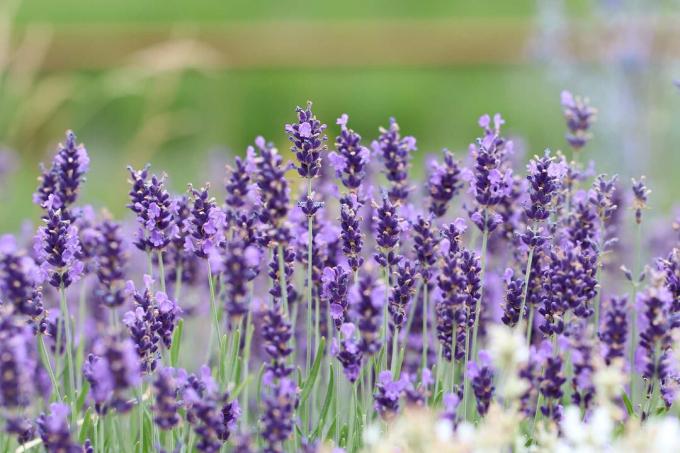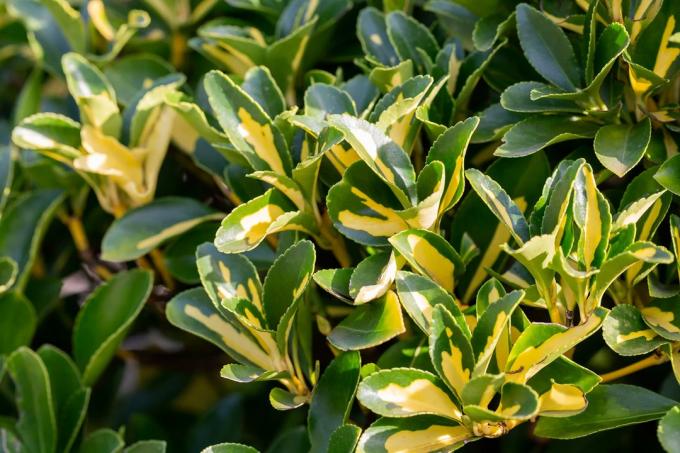
A grave planting should be easy to care for and the plants should not get too big. There are both annuals and perennials for the cemetery that are small in stature and don't take up much space.
In a nutshell
- always prefer slow-growing varieties for graves with perennial species
- regular removal of inflorescences promotes flowering in many species
- Cover partially frost-resistant plants with brushwood in autumn
Table of contents
- Small plants from B – E
- small growing plants with F
- J-K
- Small plants with L
- M – S
- W – Z
- frequently asked Questions
Small plants from B – E
heather (Calluna vulgaris)

The common heather is characterized by a long flowering period. Even faded inflorescences still look decorative on the grave.
- growth height: 10-20cm
- growth width: 25-40cm
- leaves: needle-like, dark green
- blossom: bud-like, pink or white
- heyday: October – December
- lifespan: theoretically perennial in favorable locations, some varieties have limited frost resistance
boxwood (Buxus sempervirens)

The boxwood is ideal for a double grave and can be planted there as a solitary plant or in a group. It is particularly easy to cut and can be brought into beautiful shapes without much prior knowledge.
- growth height: 40-50cm
- growth width: 40-50cm
- leaves: ovate, glossy, blue-green
- blossom: inconspicuous
- heyday: March May
- lifespan: perennial
A notice: Use for that grave planting only slow-growing breeds such as the “Blauer Heinz” variety. Otherwise, the boxwood can quickly become very large.
ice begonia (Begonia semperflorens)

ice begonias not only have pretty flowers, but some varieties also have an interesting foliage color. They are very easy to care for, you don't even have to remove faded flowers.
- growth height: 15-30cm
- growth width: 15-20cm
- leaves: oval, irregularly serrate, tapering, shiny
- blossom: plain, white, pink, red
- heyday: May – October
- lifespan: annual, very sensitive to frost
small growing plants with F
Fan juniper (Microbiota decussata)

The fan juniper develops well both in the sun and in the shade. It is not only compatible with cuts, it is also step-resistant and therefore suitable for larger burial sites.
- growth height: 20-40cm
- growth width: 100-150cm
- leaves: needle-like, fresh green
- blossom: inconspicuous
- heyday: April June
- lifespan: perennial
cinquefoil (Potentilla tridentata)

The cinquefoil quickly forms a dense growth, which means that weeds no longer have a chance on the grave. The plant is quite undemanding and only needs pruning in the fall.
- growth height: 10-20cm
- growth width: 20-40cm
- leaves: glossy, evergreen
- blossom: simple, white
- heyday: April May
- lifespan: perennial
Busy Lizzie (Impatiens walleriana)

As grave planting choose the hard-working Lieschen varieties that are optimally adapted to sunny or semi-shady locations. As a result, they are not difficult to care for and produce beautiful flowers.
- growth height: 20-40cm
- growth width: 20-40cm
- leaves: oval, tapering, edges serrated
- blossom: large, single, open or filled, available in many different colors
- heyday: May – October
- lifespan: annual
J-K
Japanese Azalea (Rhododendron obtusum)

The Japanese azalea is characterized by a dense flower floor. It is hardy, but should be protected with some brushwood in a dry winter.
- growth height: 20-30cm
- growth width: 45-55cm
- leaves: smooth, elliptical, dark green, evergreen
- blossom: double, large, pink or white
- heyday: May June
- lifespan: perennial
Small-leaved periwinkle (Vinca minor)

The small-leaved IEvergreen is suitable for graves in full sun as well as for shady places. Overlying shoots root again and again, which quickly forms dense mats.
- growth height: 10-30cm
- growth width: 25-50cm
- leaves: elliptical, shiny, leathery
- blossom: light violet to violet-blue, bowl-shaped
- heyday: April May
- lifespan: perennial
Small plants with L
lavender (Lavandula angustifolia)

The lavender forms flowering shoots again immediately after flowering. It grows compact and doesn't take up much space on a grave.
- growth height: 20-30cm
- growth width: 20-30cm
- leaves: elongated, narrow, grey-green
- blossom: spike-shaped, simple, violet-blue
- heyday: June August
- lifespan: perennial
A notice: The French lavender (Lavandula stoechas), which is slightly smaller than the common lavender, is not hardy. It can only be overwintered in very mild regions, as it does not tolerate frost.
liver balm (Ageratum houstonianum)

In good conditions, the liver balm forms large cushions. You should remove faded inflorescences regularly, as this promotes the formation of more flowers.
- growth height: 30 – 60 cm
- growth width: 25-30cm
- leaves: ovoid to cordate, green
- blossom: in dense clusters, violet to blue
- heyday: May – October
- lifespan: annual
M – S
loyal to men (Lobelia erinus)

The men's faithful is an eye-catcher on the grave with its lush flowers. Just one or two plants are enough as visual highlights.
- growth height: 15-30cm
- growth width: 20-30cm
- leaves: lanceolate, narrow
- blossom: simple, blue, violet, white
- heyday: July September
- lifespan: annual
Spindle bush (Euonymus fortunei)

The spindle tree is popular with the public because of its decorative foliage grave planting. It multiplies via foothills and can even form adhesive roots on rock.
- growth height: 25-40cm
- growth width: 50-80cm
- leaves: elliptical or oval, evergreen, depending on the variety green, variegated or golden yellow
- blossom: inconspicuous
- heyday: June July
- lifespan: perennial
pansies (Viola)

The pansies is one of the most popular grave plants. Due to the variety of flowers, a varied picture can be created.
- growth height: 10-20cm
- growth width: 15-25cm
- leaves: heart-shaped, notched, dull
- blossom: depending on the type, available in almost all colors, different sizes, filled or single
- heyday: March – August
- lifespan: biennial, usually planted in early autumn or early spring
A notice: Theoretically, pansies would be perennial. However, the plants form seeds, which means that they usually die off when the seeds ripen, unless the faded flowers are removed.
marigold (tagetes)

The marigold also blooms reliably at the grave, even if it is rarely watered. Just make sure that young plants are not eaten by snails.
- growth height: 30-50cm
- growth width: 20-40cm
- leaves: feathered
- blossom: simple or double, yellow, orange to reddish
- heyday: May – October
- lifespan: annual
W – Z
Waldsteinia (Waldsteinia ternata)

The Waldsteinia is an evergreen ground cover. Its bright yellow flowers are eye-catching early in the year.
- growth height: 10-15cm
- growth width: 30 – 60 cm
- leaves: threefold, dentate, slightly shiny, hairy
- blossom: golden yellow, cupped
- heyday: April May
- lifespan: perennial
two teeth (Bidens ferulifolia)

The two-tooth prefers dry locations and is ideal for graves in the direct sun. In order to maintain the willingness to flower, faded inflorescences should be removed regularly.
- growth height: 15-30cm
- growth width: 30-50cm
- leaves: finely feathered
- blossom: yellow, simple, slightly cupped
- heyday: May – October
- lifespan: annual
frequently asked Questions
Yes, when planting a grave you can combine annuals and perennials. Perennial plants usually set the accents, such as solitary plants in the middle or at the corners, while annual plants can be used as splashes of color that vary from year to year.
The ideal time to plant perennials on graves is early fall. Then the plants have enough time to take root in the ground and survive the frost well. Alternatively, you could also put perennial plants on the grave in early spring. In the spring, however, the risk of prolonged dry spells is greater, which is why you must ensure that the soil is always well moistened until the plants are rooted.
Perennial flowering plants should be cut immediately after flowering. This encourages the formation of another flower. Perennial green plants should be brought into shape in the frost-free spring so that they do not overgrow over the summer. A vigorous pruning can be done in early autumn.
